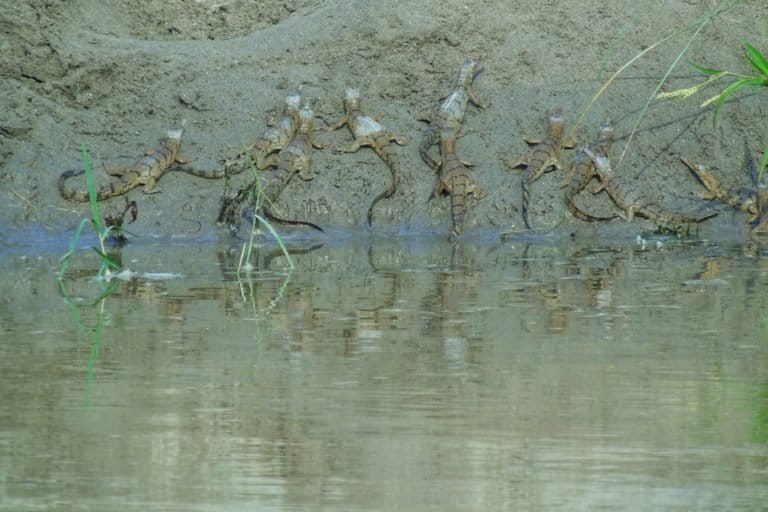- Twenty-eight gharial hatchlings have been spotted in a tributary of Nepal’s Karnali River, the first sign of successful nesting in this waterway in at least 16 years.
- The discovery by villagers living near Bardiya National Park came on June 15, two days before World Crocodile Day, and indicates the critically endangered species is on the road to recovery.
- Nepal is home to about 200 breeding gharials, and since 1978 has carried out conservation and breeding programs for the species.
KATHMANDU — Villagers living near Nepal’s Bardiya National Park have discovered the first successful nesting and breeding site of gharial crocodiles in the park in more than 16 years. They spotted a total of 28 hatchlings in the Geruwa River, one of the tributaries of the Karnali River, the longest in Nepal.
The discovery, two days before World Crocodile Day on June 17, indicates the critically endangered species, Gavialis gangeticus, is on the road to recovery.
“We had been spotting a gharial in the river for the last two years,” nature guide Manju Mahatara from Thakurdwara, near the entrance to the national park, told Mongabay. “Until recently, people used to go close to the gharial as it basked in the sun to take photos and it didn’t seem to mind. However around three to four weeks ago, it showed signs of aggression, leading us to believe that it must have laid eggs.
“We spotted the hatchlings on June 15 when we observed the gharial,” Mahatara added. She said she and her team believe that as a male gharial hadn’t been spotted in the river, the female gharial may have mated downstream in India’s Katarniaghat Wildlife Sanctuary, just across the border from Bardiya, and traveled upstream to lay her eggs.
Gharials, with their distinctive slender snouts, once roamed the entire lower reaches of the Ganges River, of which the Karnali is a tributary.
The species is considered critically endangered on the IUCN Red List, with its range limited to India and Nepal. Fewer than 200 breeding adults survive in the wild in Nepal, with the main threats to the species coming from fishing, changes in river flow, and poaching. With the survival rate of newborns in the wild hovering around 1%, the governments of India and Nepal have launched captive-breeding programs in different locations to maximize the number of eggs that survive; the healthy hatchlings are released back into the river systems.

“This is an indication that gharials are breeding in the wild and there are both males and females in the river system,” said conservationist Narendra Man Babu Pradhan from the IUCN’s Nepal office.
“The last time we spotted hatchlings in the Karnali was around 2005, 2006,” said Ramesh Kumar Thapa, former warden of Bardiya National Park.
Nepal launched the Gharial Conservation and Breeding Center as a project in Chitwan National Park in 1978, when the population of the crocodiles in the park was less than 81. Another crocodile conservation center was established in Bardiya National Park in 1982, with 25 eggs collected from the Babai. In 2010, about 10 gharials were brought from Chitwan as a starter population.
According to the Gharial Conservation Action Plan for Nepal (2018-2022), construction of mega dams for irrigation and electricity, without proper fish passages, is one of the major threats to the species. The dams not only obstruct the migration of gharials and other aquatic species, but also affect the crocodiles’ nesting and basking sites.
The conservation plan also identifies another threat coming from disposal of domestic and industrial sewage and chemical effluents from factories producing paper pulp, cement and rubber. Extraction of sand and gravel from riverbeds for construction has also had a negative impact on gharials. Similarly, gill nets used in fishing can also entangle gharials and lead to their deaths.
Banner Image: Gharial hatchlings seen on the banks of the Geruwa river in western Nepal. Image courtesy of Bardiya National Park, Nepal.
Feedback: Use this form to send a message to the author of this post. If you want to post a public comment, you can do that at the bottom of the page.
